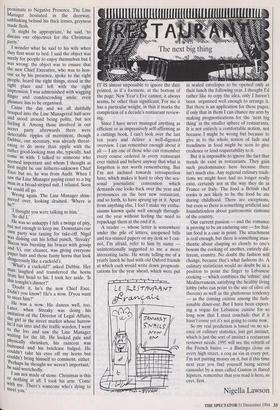IT IS almost impossible to ignore the date printed, as
if a footnote, at the bottom of the page: New Year's Eve cannot, it always seems, be other than significant. For me it has a particular weight, in that it marks the completion of a decade's restaurant review- ing.
Since I have never managed anything as efficient or as impressively self-affirming as a cuttings book, I can't look over the last ten years and deliver a well-digested overview. I can remember enough about it all — I am one of those who can remember every course ordered in every restaurant ever visited and believe anyway that what is forgotten is not worth remembering. But I'm not inclined towards retrospection here, which makes it hard to obey the sea- sonal journalistic convention which demands one looks back over the year and pronounces on the best new restaurant, and so forth, to have sprung up in it. Apart from anything else, I feel I make my enthu- siasms known quite well enough through- out the year without feeling the need to repackage them at the end if it.
A reader — whose letter is somewhere under the pile of letters, unopened bills and tea-stained papers on my desk so I can- not, I'm afraid, refer to him by name unintentionally suggested to me a more interesting tactic. He wrote telling me of a yearly lunch he had with old Oxford friends at which each would write down prognosti- cations for the year ahead, which were put in sealed envelopes to be opened only at their lunch the following year. I thought I'd rather like to copy the idea, only I haven't been organised well enough to arrange it. But there is an application for these pages, if only that in them I can chance my arm by making prognostications for the 'next big thing' in the smaller sphere of restaurants. It is not entirely a comfortable notion, not because I might be wrong but because to give in to the whole notion of fads and trendiness in food might be seen to give credence or lend respectability to it.
But it is impossible to ignore the fact that trends do exist in restaurants. They gain such predominance here because there isn't much else. Any regional culinary tradi- tions we might have had no longer really exist, certainly not in the way they do in France or Italy. The food a British chef cooks is not likely to be the food he ate during childhood. There are exceptions, but even so there is something artificial and foundationless about gastronomic customs of the country.
Our current passion — and the romance is proving to be an enduring one — for Ital- ian food is a case in point. The attachment is real enough, but there is something inau- thentic about clasping so closely to one's bosom the cooking of another, entirely dif- ferent, country. No doubt the fashion will change, because that's what fashions do. A culinary statistician would no doubt be in a position to point the finger to Lebanese cooking — which combines the 'ethnic' and Mediterranean, satisfying the healthy living lobby (who can point to the use of olive oil therein) as well as the gluttonous tendency — as the coming cuisine among the fash- ionable diner-out. But I have been expect- ing a vogue for Lebanese cuisine for so long now that I must conclude that if it hasn't come yet it's not going to come now.
So my real prediction is based on no sci- ence or culinary statistics, just gut instinct, which is just the sort of instinct a restaurant reviewer needs. 1995 will see the rebirth of the French bistro — a Bistingo clone on every high street, a coq au yin in every pot. I'm not putting money on it, but if this time next year you find yourself being served cassoulet by a man called Gaston in flared hipsters, remember that you read it here, as ever, first.
Nigella Lawson


























































 Previous page
Previous page